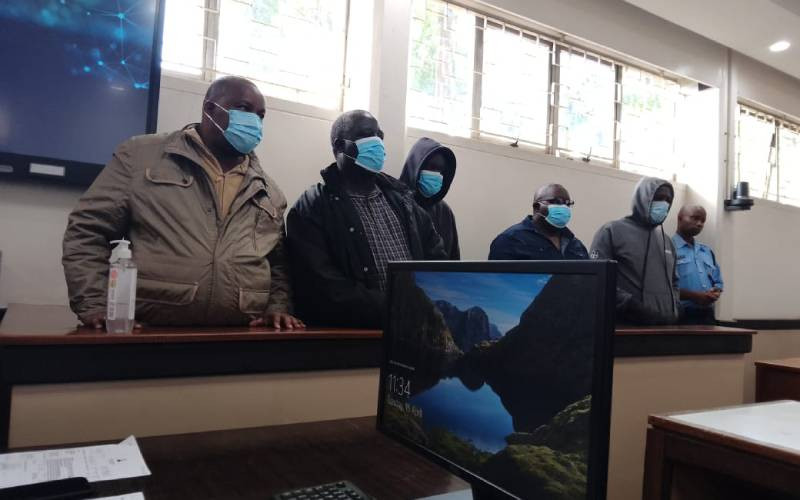
In July 2009, a ship carrying 15,000 tonnes of Diammonium Phosphate (DAP) fertiliser from the US to the port of Mombasa was diverted on the high seas back to the US before docking.
This is after officials from the Kenya Bureau of Standards (Kebs) discovered that the fertiliser in the vessel that was being brought into the country was substandard.
The DAP fertiliser being ferried by the ship contained a heavy metal pollutant chemical element called Cadmium, in amounts that did not meet the Kenyan standards. Cadmium is also present in the manufacturing of some types of batteries.
The heavy metal pollutant poses serious risk to the country’s fertile soil considering the fact that Kenyan farmers use the highest average of fertiliser per hectare in Africa, according to a recent report published by the Agrarian Green Revolution for Agriculture (AGRA) 2013.
An average of 32kg of fertiliser is applied per hectare in Kenya. But this falls short of the international recommended standards, a new report has indicated. This is against the recommended 50kg
per hectare. Malawi closely follows Kenya at 29 and Zimbabwe at 28. Uganda comes fourth at 27kg per hectare.
Globally, Netherlands uses 238kg of fertiliser per hectare. India comes second — using 167kg of fertiliser. Chronic hunger report, Africa Agriculture Status Report, Focus on Staple Crops 2013, indicates that Niger, a country that experiences chronic hunger, does not apply any fertiliser. Cadmium is found in phosphate rocks that are used in the manufacture of DAP fertiliser.
The chemical is of no use to the human body and if anything, it is toxic even at low levels.
The negative effects of cadmium are numerous and can impact nearly all systems in the body, including cardiovascular, reproductive, the kidneys, eyes, and it is a big cause of brain cancer.
The element affects blood pressure, causes bone damage and renal system diseases in children. It also causes grievous and irreparable damage to the environment. Cadmium easily gets into the crop chain during fertilisation and is eventually consumed my humans.
Among the worst cases where health disasters have directly been linked to cadmium poisoning was in Japan where in the 1950s, a mining firm discharged cadmium into the Jinzugawa River, in Toyama, exposing residents to cadmium through drinking water and polluted rice.
Body organs
Farmers in the area reported, weak and brittle bones and other ailments affecting other body organs such as kidneys. The case is classified as one of Japan’s four worst pollution-caused diseases.
As a result of fatal effects, governments all over the world have put standard measures to ensure DAP fertiliser imported into their realms, contain as minimal amount of cadmium as possible.
Stay informed. Subscribe to our newsletter
Prior to 2009, and before the 15,000 tonnes of substandard DAP fertiliser being diverted on the high seas, Kebs had unconditionally specified cadmium content in DAP imported into the country from any foreign base not to exceed seven parts per million (ppm – which is a measure of the level of cadmium in fertiliser). But six years later, in 2015, the Kebs technical committee reviewed the cadmium level upwardly in an alarming trajectory.
The standards body increased the cadmium level from the initial seven ppm, to a maximum of 30ppm, higher than in any country in the region. Kebs bowed to pressure from greedy importers who were only keen to maximise on profits at the expense of polluting the country’s healthy soil.
The new review opened Kenyan borders to floods of cheap fertiliser imports that contain gross amounts of the highly pollutant metal from all questionable sources all over the world.
And while at it, exposing Kenyan consumers to grave health risks. A source who sat in the 2015 Kebs technical committee that reviewed the cadmium content from seven to 30ppm, and who is currently a major player in Kenya’s shadowy fertiliser-import business made shocking revelations in what could open a can of worms.
He revealed to the Financial Standard that intense lobbying from importers who could not afford to bring into the country DAP fertiliser with low cadmium levels, because of its high costs, outmuscled the Kebs technical committee into giving in into demands to increase the level of the pollutant cadmium in fertilizers brought into the country.
“In 2015, I was among the experts who sat in that Kebs technical committee that reviewed the amount of cadmium metal that should be contained in DAP fertiliser that is imported into the country. As experts, we knew any level of cadmium higher than 7ppm in the crop chain, will surely kill our consumers with cancer and kidney diseases.
But from the word go, the whole review was compromised. So much lobbying had taken place from importers and money changed hands that, most of the members of the committee were in the importers’ pockets. The level of cadmium was raised to 30ppm through the backdoor,” the source who cannot be named due to his professional relationship with Kebs explains.
Kebs Managing Director Charles Ongwae, in a response to queries by the Financial Standard agreed that the importers had a hand in influencing the review of the cadmium levels into fertiliser in amounts that are very toxic to the health of consumers, and the environment.
“There was a complaint from importers that the level of cadmium allowed in DAP fertiliser in our country is low compared to other countries. We decided to harmonise with levels from other countries,” Mr Ongwae said.
Ongwae’s defence comes even when neighbouring Tanzania, which had set the cadmium level at seven ppm at par with Kenya, refused to increase its own levels when Kenya increased.
Regional imports
Tanzania maintains its cadmium levels to the safety measure of seven ppm - which is not harmful to its consumers. The same source confirmed that currently Rwanda imports its DAP fertiliser through Tanzania and adheres to Tanzania’s standards, avoiding Kenya.
Uganda has been scaling down its DAP imports through Kenya, also preferring to import through Tanzania. Kenya imports its bigger bulk of DAP fertiliser from Morocco and Saudi Arabia, two countries which have been cited internationally for exporting DAP with huge amounts of cadmium, and whose exports have been barred in many countries.
Source market
One of Moroccos’s biggest phosphate fertiliser exporting companies OCP Group has an office in Nairobi’s Landmark Plaza and is in contact with many local players who directly source fertiliser from it before channeling to farmers through a vast chain of middlemen.
The company that prides itself on its website as “the exclusive caretaker of the world’s largest phosphate resources”, is one of the biggest phosphate fertiliser exporters in the world.
Speaking to the Financial Standard OCP Group Country Manager for Kenya Wamae Mwangi said: “Morocco’s phosphate rocks that manufacture DAP fertiliser have unusually high levels of cadmium. But the fertilizer we bring into Kenya adheres to Kebs 30ppm level.”
The Arabian company that exports DAP fertilizer to Kenya, is called the Saudi Arabian Mining Company (Maaden). The company has no formal office in the country.
Mohamed Alsheik, Maaden’s Chief Executive Officer did not reply to our emails concerning the level of the pollutant metal Cadmium in the DAP fertiliser his company exports to Kenya.
Morocco is currently involved in a tussle with the European Union (EU) concerning EU’s recent move to regulate the multi-billion-euro fertiliser industry.
The EU holds that the maximum level of the toxic metal cadmium that is to be allowed in phosphate fertiliser imported within its domain is to be 20ppm.
That is 10ppm units lower than Kenya. Later this year, the EU will be holding a meeting to address rules on fertilisers that is expected to bring the cadmium level even lower to 10ppm.
Morocco is lobbying the EU not to lower the cadmium levels, a lobbying that has been met with stark resistance from Scandinavian countries as well as Austria and the Baltic republics.
They have have insisted that the cadmium level has to go down due to the health concerns that have been raised in those countries.
Morocco now has only one option – to invest in very expensive technology that brings the cadmium levels down.
Kenya also imports phosphate fertiliser from the Ukraine and Russia, where Cadmium levels are low, but most of the importers, especially those who lobbied Kebs, cannot afford to import phosphates from those countries because of high freight charges and the expensive nature of those fertilisers.
The country hardly imports from the US also due to high freight charges. Other than the obvious health risks that the metal poses for Kenyans, the country’s flourishing horticulture industry might also be at risk of being locked out of lucrative export markets.
Toxic metals
Jacob Nyaduru, a technical official with the Tea Research Foundation says tea production is a sensitive venture especially in terms of the fertiliser that is used. “Toxic metals in fertilisers usually get into tea crops easily through the soil and can be very harmful to consumers. We are a big tea exporting country and this cannot augur well with our customers, leave alone the effects it could have to local consumers,” Mr Nyandaru says.
Kenya Tea Development Agency last year imported 74,800 tonnes of nitrogen, phosphorus and potassium (NKP) fertiliser for tea farmers aimed at growing yields.
Prof Maina Karuiru an expert on horticulture farming says apart from Cadmium, Phosphate fertilisers are also acidic in nature and inhibit plants from absorbing other nutrients which leads to low yields. “I am shocked by such amounts of cadmium in the DAP we import. Cadmium plus high acidity is lethal,” he observed.
“Farmers especially from the North Rift are complaining of low yields because the DAP they are using is inhibiting crops from absorbing other nutrients. If the little we are yielding contains that much cadmium then our policy makers in the agricultural sector are leading us the wrong way,” Prof Karuiru says.
With the risk of lifestyle related diseases hanging over the populace delicately like the sword of Damocles, and an over-burdened healthcare system that the government has been unable to support, Phosphate fertilisers with clear Kebs standard stickers could be the next national killers.
 The Standard Group Plc is a
multi-media organization with investments in media platforms spanning newspaper
print operations, television, radio broadcasting, digital and online services. The
Standard Group is recognized as a leading multi-media house in Kenya with a key
influence in matters of national and international interest.
The Standard Group Plc is a
multi-media organization with investments in media platforms spanning newspaper
print operations, television, radio broadcasting, digital and online services. The
Standard Group is recognized as a leading multi-media house in Kenya with a key
influence in matters of national and international interest.
 The Standard Group Plc is a
multi-media organization with investments in media platforms spanning newspaper
print operations, television, radio broadcasting, digital and online services. The
Standard Group is recognized as a leading multi-media house in Kenya with a key
influence in matters of national and international interest.
The Standard Group Plc is a
multi-media organization with investments in media platforms spanning newspaper
print operations, television, radio broadcasting, digital and online services. The
Standard Group is recognized as a leading multi-media house in Kenya with a key
influence in matters of national and international interest.










